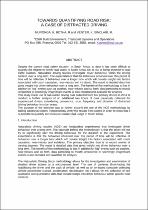JavaScript is disabled for your browser. Some features of this site may not work without it.
- ResearchSpace
- →
- Research Publications/Outputs
- →
- Conference Publications
- →
- View Item
| dc.contributor.author |
Muronga, Khangwelo

|
|
| dc.contributor.author |
Botha, Rika

|
|
| dc.contributor.author |
Venter, Karien

|
|
| dc.contributor.author |
Sinclair, M

|
|
| dc.date.accessioned | 2018-11-28T13:01:06Z | |
| dc.date.available | 2018-11-28T13:01:06Z | |
| dc.date.issued | 2018-10 | |
| dc.identifier.citation | Muronga, K. et al. 2018. Towards quantifying road risk: A case of distracted driving. International Road Federation/ South African Road Federation Conference, 7-9 October 2018, Durban ICC, South Africa | en_US |
| dc.identifier.uri | http://www.sarf-irf2018.co.za/papers/ | |
| dc.identifier.uri | http://www.sarf-irf2018.co.za/wp-content/uploads/2018/10/Venter-K.pdf | |
| dc.identifier.uri | http://hdl.handle.net/10204/10549 | |
| dc.description | Paper presented at the International Road Federation/ South African Road Federation Conference, 7-9 October 2018, Durban ICC, Durban, South Africa | en_US |
| dc.description.abstract | Despite the current road safety situation in South Africa, to date it has been difficult to quantify the degree to which road users in South Africa are at risk of being involved in road traffic crashes. Naturalistic driving studies investigate driver behaviour within the driving context, over a long-term. The expectation is that the behaviour observed over this period of time will be reflective of behaviour over a longer time which will provide insight into factors associated with crash causation, near-misses and incidents. The result is detailed data that gives insight into driver behaviour over a long term. The benefit of this methodology is that in addition to “big” events such as crashes, near-misses and so forth, data pertaining to mostly unreported or seemingly insignificant events is also recoded and available for analysis. This study made use of naturalistic driving data collected from four primary drivers in 2014 to conduct a further analysis of an additional two hours of data previously collected for experienced drivers considering prevalence, type, frequency and duration of distracted driving behaviour in urban areas. The purpose of the exercise was to further expand the use of the NDS methodology by adding additional coders, independently verify the results from coders in order to show that it is possible to quantify and measure unsafe road usage in South Africa. | en_US |
| dc.language.iso | en | en_US |
| dc.relation.ispartofseries | Worklist;21726 | |
| dc.subject | South African road safety | en_US |
| dc.subject | Distracted driving | en_US |
| dc.subject | Driver behaviour | en_US |
| dc.subject | Road safety | en_US |
| dc.title | Towards quantifying road risk: A case of distracted driving | en_US |
| dc.type | Conference Presentation | en_US |
| dc.identifier.apacitation | Muronga, K., Botha, R., Venter, K., & Sinclair, M. (2018). Towards quantifying road risk: A case of distracted driving. http://hdl.handle.net/10204/10549 | en_ZA |
| dc.identifier.chicagocitation | Muronga, Khangwelo, Rika Botha, Karien Venter, and M Sinclair. "Towards quantifying road risk: A case of distracted driving." (2018): http://hdl.handle.net/10204/10549 | en_ZA |
| dc.identifier.vancouvercitation | Muronga K, Botha R, Venter K, Sinclair M, Towards quantifying road risk: A case of distracted driving; 2018. http://hdl.handle.net/10204/10549 . | en_ZA |
| dc.identifier.ris | TY - Conference Presentation AU - Muronga, Khangwelo AU - Botha, Rika AU - Venter, Karien AU - Sinclair, M AB - Despite the current road safety situation in South Africa, to date it has been difficult to quantify the degree to which road users in South Africa are at risk of being involved in road traffic crashes. Naturalistic driving studies investigate driver behaviour within the driving context, over a long-term. The expectation is that the behaviour observed over this period of time will be reflective of behaviour over a longer time which will provide insight into factors associated with crash causation, near-misses and incidents. The result is detailed data that gives insight into driver behaviour over a long term. The benefit of this methodology is that in addition to “big” events such as crashes, near-misses and so forth, data pertaining to mostly unreported or seemingly insignificant events is also recoded and available for analysis. This study made use of naturalistic driving data collected from four primary drivers in 2014 to conduct a further analysis of an additional two hours of data previously collected for experienced drivers considering prevalence, type, frequency and duration of distracted driving behaviour in urban areas. The purpose of the exercise was to further expand the use of the NDS methodology by adding additional coders, independently verify the results from coders in order to show that it is possible to quantify and measure unsafe road usage in South Africa. DA - 2018-10 DB - ResearchSpace DP - CSIR KW - South African road safety KW - Distracted driving KW - Driver behaviour KW - Road safety LK - https://researchspace.csir.co.za PY - 2018 T1 - Towards quantifying road risk: A case of distracted driving TI - Towards quantifying road risk: A case of distracted driving UR - http://hdl.handle.net/10204/10549 ER - | en_ZA |






